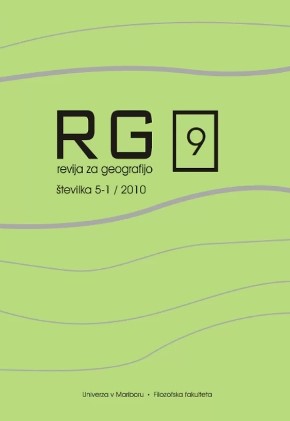Grain Amaranth as an Alternative and Perspective Crop in Temperate Climate
DOI:
https://doi.org/10.18690/rg.5.1.4011Keywords:
grain amaranth, nutrition value, utilisationAbstract
As a consequence of globalisation and industrialisation of agriculture, global food security has become increasingly dependent on only a handful of fertilisation and energy high demanding plant species. This involution has increased the vulnerability of agriculture, reduced genetic diversity, provoked some environmental problems and impoverished the human diet. The mentioned facts stimulate the retrieving of alternative crops into the production. The present paper briefly describes crop importance, botany, nutritional value and utilisation of grain amaranth (Amaranthus spp.), one of the alternative crops discussed in the book Organic Production and Use of Alternative Crops. The immediate objective of this paper is to present information gained as a result of a national project on grain amaranth.
Downloads
References
Bavec, F., Bavec, M. 2006: Organic Production and Use of Alternative Crops, CRC Press/Taylor and Francis, 241 p. https://doi.org/10.1201/9781420017427
Becker, R. et al 1981: A Compositional Study of Amaranth Grain. Journal of Food Science, 46(4), p. 1175-1180. https://doi.org/10.1111/j.1365-2621.1981.tb03018.x
Bejosano, F. P., Corke, H. 1998: Protein quality evaluation of Amaranthus wholemeal flours and protein concentrates. Journal of the Science of Food and Agriculture, 76(1), p. 100-106. https://doi.org/10.1002/(SICI)1097-0010(199801)76:1<100::AID-JSFA931>3.0.CO;2-B
Berghofer, E., Schoenlechner, R. 2002: Grain Amaranth. In Belton P, Taylor J (eds.), Pseudocereals and Less Common Cereals, Grain Properties and Utilization Potential. Springer-Verlag, p. 219-260. https://doi.org/10.1007/978-3-662-09544-7
Betchart, A. A. et al, 1981: Amaranthus cruentus: Milling characteristics, Distribution of Nutrients within Seed Components, and the Effects of Temperature on Nutritional Quality. Journal of Food Science, 46 (4), p. 1181-1184. https://doi.org/10.1111/j.1365-2621.1981.tb03019.x
Bhandari, P. N., Singhal, R. S. 2001: Effect of succinylation on the corn and amaranth starch pastes. Carbohydrate polymeres, 48(3), 223-240. https://doi.org/10.1016/S0144-8617(01)00310-1
Breene, W. M. 1991: Food uses of grain amaranth. Cereal Food World, 36(5), p. 426-429.
Bressani, R. 1989: The Proteins of Grain Amaranth. Food Reviews International, 5(1), p. 13-38. https://doi.org/10.1080/87559128909540843
Dodok, L. et al., 1997: Importance and utilization of amaranth in food industry. Part 2. Composition of amino acids and fatty acids. Nahrung/Food, 41 (2), p. 108-10. https://doi.org/10.1002/food.19970410211
Early, D. K. 1990: Amaranth Production in Mexico and Peru. In Janick J, Simon JE (eds.), Advances in new crops. Timber Press, p. 140-142.
FAO, 1995: Food fortification: technology and quality control. Report of an FAO Technical Meeting held in Rome, 20-23 November 1995. FAO Food and Nutrition Paper. Rome.
FAO, 2005: The State of Food Insecurity in the World 2004. FAO. Rome.
S. Grobelnik Mlakar, M. Turinek, M. Jakop, M. Bavec, F. Bavec: Grain Amaranth … 144
Grobelnik Mlakar, S. et al 2009: Nutrition value and use of grain amaranth: potential future application in bread making. Agricultura, 7, p. 5-15.
IST World. Adding Value to Holy Grain: Providing the Key Tools for the Exploitation of Amaranth the Protein-Rich Grain of the Aztecs. Available at: http://www.istworld.org/ProjectDetails.aspx? ProjectId=a8c0340652e94d979234d7d8d2de6edc (August, 2009).
Jamriška, P. 1990: The effect of the stand organisation on the yield of amaranth (Amaranthus hypochondriacus). Rostlina Vyroba, 36 (8), p. 889-896.
Joshi, B. D., Rana, R. S. 1991: Grain Amaranths: the Future Food Crop. National Bureau of Plant Genetic Resources, New Delhi. 152 p.
Kaufman, C. S. 1992: Realizing the Potential of Grain Amaranth. Food Reviews International, 8 (1), p. 5-21. https://doi.org/10.1080/87559129209540927
Kaul, H. E. et al, 1996: The suitability of amaranth genotypes for grain and fodder use in Central Europe. Die Bodenkultur, 47 (3), p. 173-181.
Kigel, J. 1994: Development and Ecophysiology of Amaranths. In Peredes-López O (edt.), Amaranth Biology, Chemistry and Technology. CRC Press, p. 39-73.
López, M. G., Bello-Pérez, L. A., Peredes-López, O. 1994: Amaranth Carbohydrates. In Peredes-López O (edt.), Amaranth Biology, Chemistry and Technology. CRC Press, p. 107-132.
Lorenz, K. 1981: Amaranthus hypochondriacus: Characteristics of the starch and baking potential of the flour. Starch/Stärke, 33 (5), p. 149-153. https://doi.org/10.1002/star.19810330502
National Academy of Sciences, 1984: Amaranth: Modern Prospects for an Ancient Crop. National Academy Press, 76 p.
Pal, J., Singhal, R. S., Kulkarni, P. R. 2001; Physicochemical properties of hydroxypropyl derivative from corn and amaranth starch. Carbohydrate Polymers, 48 (1), p. 19-53. https://doi.org/10.1016/s0144-8617(01)00209-0
Plate, A. Y. A., Areas, J. A. G. 2002: Cholesterol-lowering effect of extruded amaranth (Amaranthus caudatus L.) in hypercholesterolemic rabbits. Food Chemistry, 76 (1), p. 1-6. https://doi.org/10.1016/S0308-8146(01)00238-2
Sanches-Marroquin, A. et al 1986: Evaluation of whole amaranth (Amaranthus cruentus), its air-classfied fractions, and blends of these with wheat and oats as possible components for infant formulas. Journal of Food Science, 51 (5), p. 1231-1234. https://doi.org/10.1111/j.1365-2621.1986.tb13092.x
Sauer, J. D. 1967: The grain amaranths and their relatives: a revised taxonomic and geographic survey. Annals of Missouri Botanical Garden, 54, p. 103-137.
Saunders, R. M., Becker, R. 1984: Amaranthus: A Potential Food and Feed Resource. In Advances in Cereal Science and Technology, volume VI. American Association of Cereal Chemists, p. 357-97.
Schnetzler, K. A., Breene, W. M. 1994: Food uses and amaranth product research: a comprehensive review. In: Peredes-López O (edt.), Amaranth Biology, Chemistry and Technology. CRC Press, p. 155-184.
Segura-Nieto, M., Barba de la Rosa, A. P., Peredes-López, O. 1994: Biochemistry of Amaranth Proteins. In: Peredes-López O (edt.), Amaranth Biology, Chemistry and Technology. CRC Press, p. 75-107.
Senft, J. P. 1979: Protein Quality of Amaranth Grain. Proceeding of Second Amaranth Conference Rodale Press, p. 43-47.
Thompson, T. 2001: Case problem: Question regarding the acceptability of buckwheat, amaranth, quinoa, and outs from a patient with celiac disease. Journal of the American Dietetic Association, 101 (5), p. 586-587. https://doi.org/10.1016/S0002-8223(01)00147-X
Williams, J. T., Brenner, D. 1995: Grain amaranth (Amaranthus species). In: Williams JT (edt.), Underutilized Crops: Cereals and Pseudocereals. Chapman, Hall, p. 129-187.
Downloads
Published
Issue
Section
License
Copyright (c) 2010 Silva Grobelnik Mlakar, Matjaž Turinek, Manfred Jakop, Martina Bavec, Franc Bavec

This work is licensed under a Creative Commons Attribution 4.0 International License.
